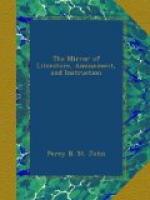“The bore’s head in hande
brynge I,
With garlaudes gay and rosemary
I praye you all synge merely,
Qui estis in
convivio.
“The bore’s head I understande
Is the chefe servyce in this lande,
Looke wherever it be fand,
Servite cum
cantico.
“Be gladde both man and lasse
For this hath ordayned our
stewarde
To chere you all this Christmasse
The bore’s head with
mustarde.”
Upon the young prince’s coronation, 1170, Henry II. “served his son at the table as server, bringing up the bore’s head with trumpets before it, according to the manner.”—Hollinshed.
The boar’s head was stuffed “with branches of rosemary, “it appears with trumpets playing, so that “it was a grande syghte.”
It would appear they had grand doings at the inns of court during Christmas. The usual dish at the first course at dinner was “a large bore’s head upon a silver platter, with minstralsye.”—Dugdale’s Orig. Jur.
Before the last civil wars, the first diet in gentlemen’s houses that was brought to table at Christmas was a boar’s head with a lemon in his mouth. At Queen’s College, Oxford, the custom is retained; the bearer of it brings it into the hall singing to an old tune, an old Latin rhyme, Caput Apri Defero, &c.
Formerly, “An English gentleman at the opening of the great day, i.e. on Christmas Day in the morning, had all his tenants and neighbours enter his hall by day-break. The strong beer was broached, and the black jacks went plentifully about with toast, sugar, nutmeg, and good Cheshire cheese. The hackin (the great sausage) must be boiled by day-break, or else two young men must take the maiden (the cook) by the arms, and run her round the market-place till she is ashamed of her laziness.”—From an old Tract, “Round about our Coal Fire, or Christmas Entertainments.”
Further, from the same Tract we find that “In Christmas holidayes,” the tables were all spread from the first to the last; the sirloins of beef, the minched pies, the plum porridge, the capons, turkeys, geese and plum-puddings, were all brought upon the board, every one ate heartily and was welcome, which gave rise to the proverb, “merry in the hall, where beards wag all.”
Misson says, “the plum-porridge is not at all inferior to the pie;” the goose pie usually made at Christmas.
Yule Cakes.—I must now call your attention to the Yule Cakes. Yule dough a little image of paste, was formerly baked at Yuletide, and presented by bakers to their customers, as Christmas candles are given away by tallow chandlers. Brand says, “the Yule dough has perhaps been intended for an image of the child, Jesus, with the Virgin Mary,” and he says, “it is now, if I mistake not, pretty generally laid aside, or at most retained only by children.” Mr. Brand was not aware that the custom still prevailed in many parts in the north. At Brough I have frequently ate of the cakes; they are figured with currants, and are usually eaten with a basin of frumity on Christmas Eve. Mince pies are there called minched, or shrid pies.




